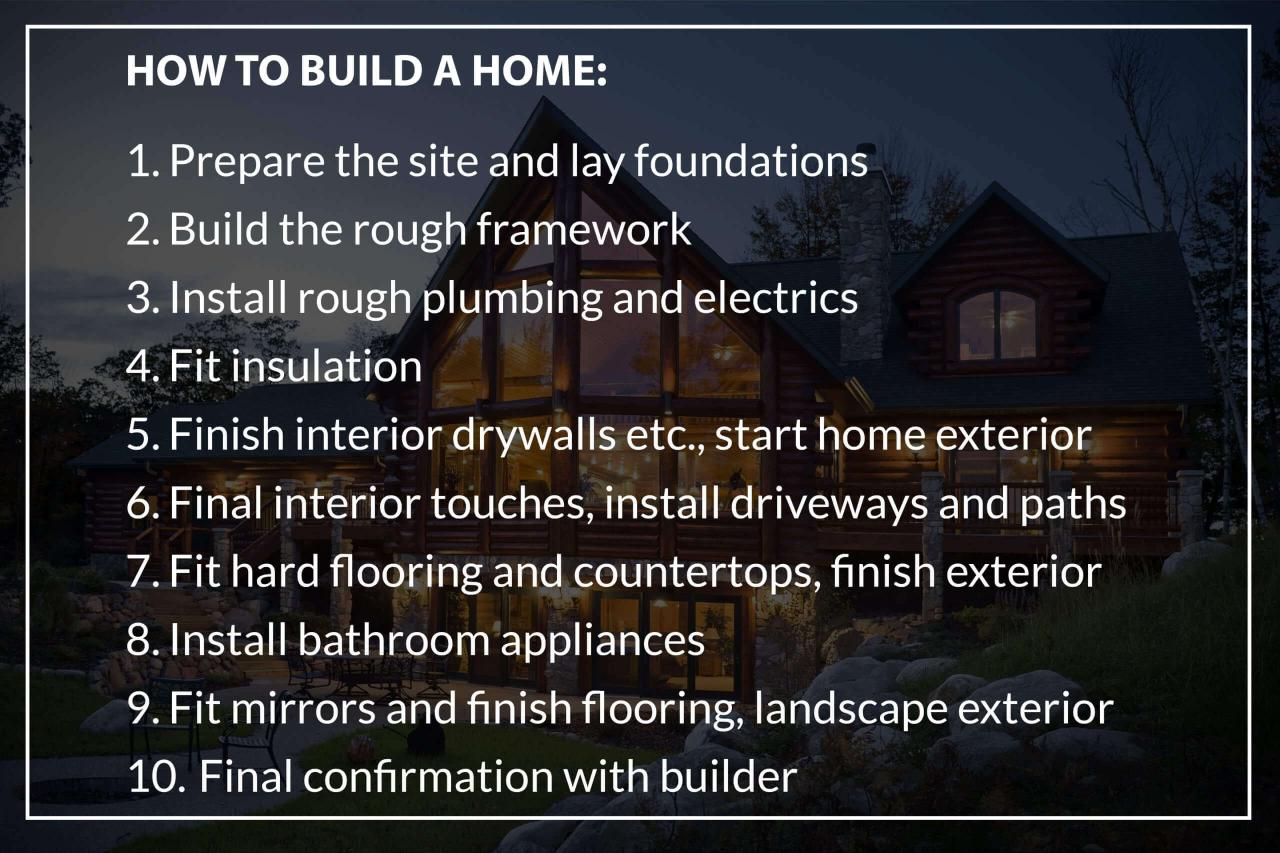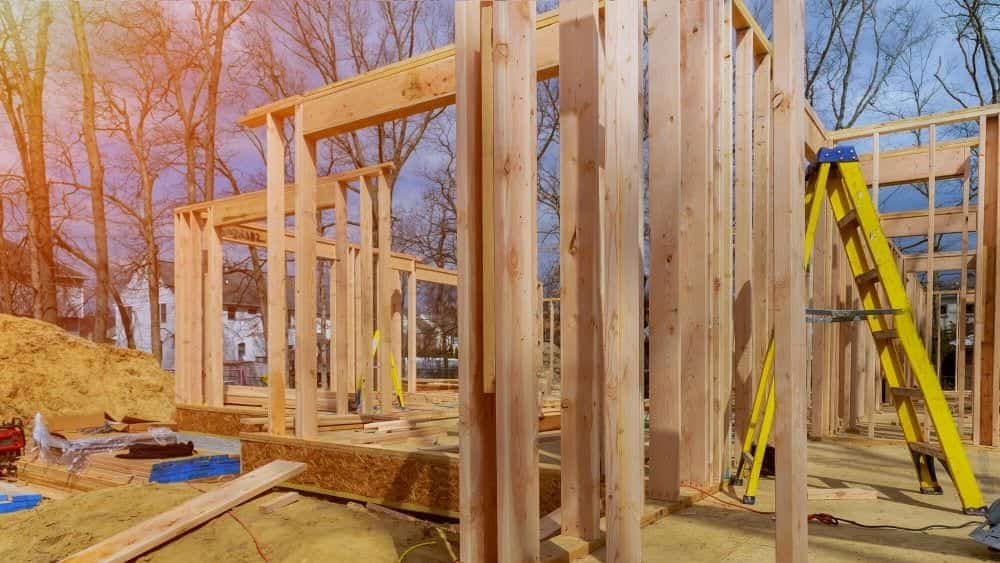Building a house step by step is a journey filled with excitement, challenges, and ultimately, the satisfaction of creating a dream home. From the initial planning stages to the final finishing touches, every step requires careful consideration and execution. This comprehensive guide will take you through the entire process, providing insights, tips, and essential information to ensure a successful and enjoyable building experience.
The journey begins with a solid foundation, both literally and figuratively. You’ll learn how to define your budget, select the perfect location, navigate the permitting process, and choose an architectural style that reflects your vision. Once the foundation is laid, you’ll delve into the construction phases, covering everything from framing and roofing to exterior and interior finishes.
Plumbing and Electrical

Once the framing and roofing are complete, it’s time to move on to the essential utilities that will make your house functional: plumbing and electrical. These systems require careful planning and professional installation to ensure safety, efficiency, and longevity. This step involves a complex interplay of pipes, wires, and fixtures, and it’s crucial to get it right.
Plumbing Fixtures and Appliances Installation
Installing plumbing fixtures and appliances involves connecting them to the main water supply and drainage system. This process requires a thorough understanding of plumbing codes and safety regulations.
- Sinks and Faucets: Connect the hot and cold water lines to the faucet and ensure the drain pipe is properly connected to the waste line.
- Toilets: Connect the toilet to the water supply and ensure the drain is properly connected to the sewer line.
- Showers and Bathtubs: Connect the shower head and faucet to the hot and cold water lines and ensure the drain is properly connected to the waste line.
- Dishwashers and Washing Machines: Connect the appliances to the water supply and drainage lines, and ensure they are properly grounded.
Water Heater Installation
Water heaters provide hot water for your home. They are typically installed in a utility room or basement and require proper ventilation and drainage.
- Gas Water Heaters: These heaters use natural gas or propane to heat water. They require a gas line connection and proper venting.
- Electric Water Heaters: These heaters use electricity to heat water. They require a dedicated electrical circuit and proper grounding.
- Tankless Water Heaters: These heaters heat water on demand, eliminating the need for a storage tank. They require a dedicated gas or electrical connection.
Plumbing System Installation
The plumbing system consists of pipes that carry water throughout the house. It includes the main water line, branch lines, and drain lines.
- Main Water Line: This line connects the house to the public water supply. It is typically made of copper or PVC pipe.
- Branch Lines: These lines connect the main water line to individual fixtures and appliances. They are typically made of copper or PEX pipe.
- Drain Lines: These lines carry wastewater from fixtures and appliances to the sewer system. They are typically made of PVC pipe.
Electrical Wiring and Fixture Installation
Installing electrical wiring and fixtures involves connecting them to the main electrical panel and ensuring they are properly grounded. This process requires a thorough understanding of electrical codes and safety regulations.
Building a house is a complex process, starting with laying the foundation and moving through stages like framing, roofing, and finishing. Each step requires meticulous planning and execution, much like the delicate process of making earrings. Just as a house needs careful attention to detail to ensure its structural integrity, earrings demand precision to achieve a beautiful and balanced design.
After all, both building a house and creating earrings are about crafting something beautiful and functional from the ground up.
- Electrical Panel: This is the central point of distribution for electricity in the house. It contains circuit breakers that protect the wiring from overloads.
- Wiring: Electrical wiring is typically made of copper or aluminum wire. It is run through walls, ceilings, and floors to connect fixtures and appliances to the electrical panel.
- Fixtures: These are the devices that use electricity, such as lights, outlets, and switches. They are connected to the wiring and grounded to ensure safety.
Central Heating and Cooling System Installation
A central heating and cooling system provides comfortable temperatures throughout the house. It consists of a furnace or air conditioner, ductwork, and a thermostat.
- Furnace or Air Conditioner: This is the unit that heats or cools the air. It is typically installed in a utility room or basement.
- Ductwork: This is a network of pipes that carries heated or cooled air throughout the house. It is typically made of metal or fiberglass.
- Thermostat: This is a device that controls the temperature of the heating and cooling system. It is typically installed on a wall.
Safety and Code Compliance
Ensuring proper safety and code compliance is crucial during plumbing and electrical installation. Here are some tips:
- Hire Licensed Professionals: Always hire licensed and insured professionals to install plumbing and electrical systems. They are familiar with local codes and safety regulations.
- Inspect Regularly: Inspect plumbing and electrical systems regularly for leaks, shorts, or other problems. This can help prevent costly repairs and ensure safety.
- Use High-Quality Materials: Use high-quality materials for plumbing and electrical systems. This will ensure longevity and reduce the risk of problems.
- Follow Manufacturer Instructions: Always follow the manufacturer’s instructions when installing plumbing and electrical fixtures and appliances.
- Obtain Permits: Obtain the necessary permits before starting any plumbing or electrical work. This will ensure your work meets local codes and regulations.
Finishing Touches
The final stages of building a house are all about adding the finishing touches that transform a structure into a home. This involves installing interior doors and windows, creating a cohesive look with trim, and bringing in the personal touches that reflect your style.
Installing Interior Doors and Windows, Building a house step by step
Installing interior doors and windows requires precision and care to ensure proper functionality and aesthetics. It’s crucial to follow manufacturer instructions and use the appropriate tools and materials.
- Measure accurately: Before purchasing doors and windows, measure the openings precisely to ensure a perfect fit.
- Prepare the openings: Ensure the openings are clean, level, and plumb before installing doors and windows.
- Install the door frame: Use shims to ensure the frame is level and plumb, then secure it to the wall.
- Hang the door: Install the hinges and attach the door to the frame.
- Install the window: Secure the window frame to the wall using screws or nails.
- Apply sealant: Seal around the perimeter of the door and window frames to prevent air leaks and moisture intrusion.
Adding Trim
Trim, including baseboards, crown molding, and casings, adds a polished look to your home. It also helps to cover imperfections in the walls and create a cohesive design.
- Choose the right trim: Select trim styles that complement the overall design of your home.
- Cut the trim to size: Measure and cut the trim pieces accurately using a miter saw or chop saw.
- Attach the trim: Secure the trim to the walls using finishing nails or construction adhesive.
- Caulk and paint: Caulk the gaps between the trim and the walls, then paint or stain the trim to match the desired finish.
Painting or Wallpapering Interior Walls
Painting or wallpapering interior walls is a great way to personalize your home and create a desired ambiance.
- Prepare the walls: Clean the walls thoroughly and fill any holes or cracks with spackle.
- Prime the walls: Apply a primer to create a smooth surface for paint or wallpaper.
- Paint the walls: Use a roller to apply paint evenly, working in sections.
- Apply wallpaper: Carefully measure and cut the wallpaper to size, then apply it to the walls using wallpaper paste.
Installing Kitchen and Bathroom Fixtures
Installing kitchen and bathroom fixtures requires careful planning and execution. It’s important to understand the plumbing and electrical connections for each fixture.
- Plan the layout: Determine the location of each fixture and ensure it aligns with the plumbing and electrical lines.
- Connect the plumbing: Connect the water supply lines and drain pipes to the fixture.
- Connect the electrical: Connect the electrical wiring to the fixture, following safety guidelines.
- Test the fixture: Turn on the water supply and check for leaks. Test the electrical connections to ensure proper functionality.
Adding Personal Touches
Personal touches make a house a home.
- Decorate with furniture and accessories: Choose furniture and accessories that reflect your personal style and create a comfortable and inviting atmosphere.
- Hang artwork and mirrors: Artwork and mirrors can add visual interest and create a focal point in a room.
- Add plants and flowers: Plants and flowers bring life and color to a home.
- Create a cozy reading nook: A cozy reading nook can provide a peaceful escape from the hustle and bustle of daily life.
Moving In Checklist
Before moving into your new home, there are a few tasks to complete.
- Clean the house thoroughly: Dust, vacuum, and mop all surfaces.
- Install smoke detectors and carbon monoxide detectors: Ensure they are working properly.
- Change the locks: For added security, change the locks on all doors.
- Set up utilities: Contact the utility companies to set up service for electricity, gas, water, and trash removal.
- Unpack and organize: Unpack your belongings and organize your new home.
Ending Remarks: Building A House Step By Step

Building a house is a significant undertaking, but with meticulous planning, careful execution, and a touch of creativity, it can be an incredibly rewarding experience. As you embark on this journey, remember that each step, from laying the foundation to adding the final touches, contributes to the realization of your dream home. Embrace the process, learn from the experts, and enjoy the journey of building a space that truly reflects your unique style and aspirations.




